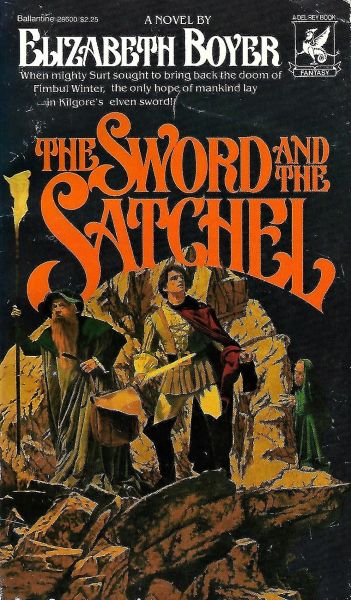The Road to Gardar
The Sword and the Satchel (World of Alfar)
By Elizabeth H. Boyer

13 Aug, 2023
1980’sThe Sword and the Satchel is the first volume in Elizabeth H. Boyer’s World of Alfar trilogy.
The ice creeps ever southward but attempts to bribe the troll thought to be responsible fail. The envoy dispatched by Valsidur of Shieldbroad fails to find the troll or any evidence it existed. While the nonexistence of the troll comes as no surprise to the relentlessly skeptical ruler, it suggests that whatever the cause of the Blight, it is beyond the ability of mortals to slow.
One day, a sword appears, driven through the ancient Brandstok oak that stands in Shieldbroad. A written note proclaims:
“Whoso pulls Kildurin from the tree shall rule over all the minions of Surt, to the confusion of the wicked and the confounding of their Power.”
Chaos ensues.
Almost everyone capable of holding a sword, save for Valsidur’s son Kilgore, tries to pull Kildurin from the oak. All fail. An extremely disreputable wizard named Warth does his pitiful best to magic the sword out and fails. Only when Kilgore belatedly tries his hand at withdrawing the magic sword is it freed from the tree.
Enter Skanderbeg, an eight-thousand-year-old wizard passing himself off as a harmless jack-of-all-trades. Skanderbeg has information mortals lack, the most urgent of which is that Kilgore and Kildurin must leave Shieldbroad immediately. Having been raised on tales of magic and heroism, Kilgore embraces his destiny.
Flight from Shieldbroad is the first step in a long journey to forbidding, frigid Gardar. Once a thriving mortal kingdom, Gardar was conquered by Surt’s forces. Even now, Surt plots to bring about the Fimbul Winter. Surt is beyond the ability of mortals to kill — many would prefer to think Surt a myth — but Kildurin will be Surt’s doom, if only the wizard and the boy can deliver the sword to Gardar.
Gardar is far away. The wilderness teems with dangers, mundane and supernatural. The ice wizard Warth dogs the pair’s heels, determined to steal Kilgore’s sword and Skanderbeg’s satchel of magic tricks. The pair manage to rescue sleeping warrior princess Asny but still, the trio’s prospects seem poor. Even if they do manage to reach Gardar, Gardar is the seat of mighty Surt’s power. Capture, imprisonment, and execution appear almost inevitable.
Only a particularly canny trio will succeed. Asny is sensible and a capable warrior. Alas, Kilgore is a headstrong boy. As for Skanderbeg? He manages to lose his magic satchel …
~oOo~
As far as I can tell, the Alfar who left the sword and prophecy for Kilgore entrusted the task on which the fate of the world depended to a mortal youth and his dubiously competent mentor because … Surt is dangerous and if someone was going to die carrying out a doomed quest, they’d rather it not be anyone Alfar.
The Sword and the Satchel is a fine example of commercial fantasy fiction of its era, one in which publishers like Del Rey and editors like the del Reys were searching energetically for material sufficiently like The Lord of the Rings to convince readers to part with $$$.
In many ways, The Sword and the Satchel is much like The Lord of the Rings. It is very, very much like The Lord of the Rings. Readers familiar with the Tolkien will recognize favourite scenes as they appear in new garb1. The author has not concealed her inspirational material.
Boyer distinguishes her novel from Tolkien’s in a number of ways.
First: there are similarities but there isn’t a one-to-one correspondence. Skanderbeg isn’t Gandalf; Gandalf was more competent and wouldn’t have lost his satchel so easily. Kilgore isn’t a naïve hobbit bravely questing because someone must, but a headstrong teen determined to relive the legends of old. Warth is a Gollumized Saruman. As for Asny, she does not correspond to any LOTR character.
Second: Boyer sets her adventure in an explicitly Norse world. Indeed, at one point the trio recapitulate myth, undertaking the same tasks at which Thor and company failed2.
Third: Boyer adds a considerable element of humor to the story. Her characters may take themselves very seriously3. The novel does not. Adventures and dangers abound but this isn’t some modern grim fantasy. People, even antagonists, have time to have fun along the road to Gardar.
The Sword and the Satchel is out of print. In fact, as far as I can tell, all eleven of Boyer’s novels are out of print. Boyer appears to have sold mainly to Del Rey in America4. Later Boyers got fewer printings than early Boyers. After 1995’s Keeper of Cats, only silence. Boyer is not the only Del Rey author to cease publication around that time.
1: Except for the scene inspired by the Arthurian tales. You know which one.
2: It falls to Asny to recognize the situation and deal with it appropriately.
3: That said, the characters don’t always take each other seriously.
“Just because I come from Shieldbroad, do you think I’m totally ignorant?” he demanded with wounded pride.
“Yes,” Asny said.
Harsh words for the youth who rescued her from endless sleep. In Asny’s defense, it’s possible that had she been the one with the magic sword, this would have been a novella.
4: UK’s Corgi reprinted early Boyer novels until 1990’s The Curse of Slagfed, after which they stopped.
